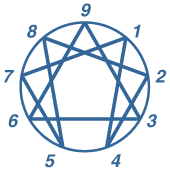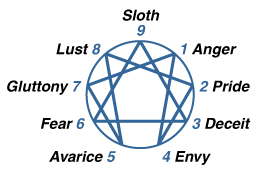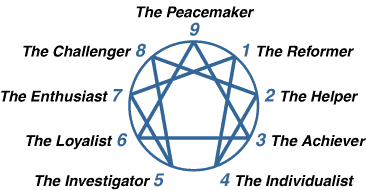Enneagram
 |
This month's Missal explores the possibility of self-discovery via the enneagram. Coming into popularity in the second half of the twentieth century, this ancient symbol has many meanings ascribed to it, as well as varied tales of its origins. From the Sufi's and mystical Judaism, to Plato and Plotinus, there is an enneagram origin theory to suit every system of spiritual or psychological work.
In modern times the enneagram, or 9 pointed symbol that currently has that name, was introduced by George Gurdjieff around 1915-20. He used the symbol as a way to show the process of transformation in man from personality back to essence or original being. Various dances and movements were used in conjunction with the symbol to help students in the journey to essence by illustrating the laws of three and seven. He did not use it as a means of mapping the human psyche and its character fixations.
|
"Gurdjieff's presentation of the enneagram did not apply directly to personality or character types, .....What instead was characteristic of Gurdjieff's presentation of the enneagram was that he described it as a symbol relating the law of the triad (law of three) to the law of the octave (law of seven). Thereby he brought the enneagram into relation with the form of the musical scale." - David Eyes
|
 |
The so-called "Traditional Enneagram" only goes back to the late 1960's and early 70's when Oscar Ichazo first began teaching it in various forms, calling it the enneagon. Ichazo came upon the scene in Arica, Chile, claiming to have been instructed in a 'school' of apparent Gurdjieffian origins. He soon after started The Arica School and taught Americans John Lilly and Claudio Naranjo among others, the later of whom went on to formulate his own version of enneagram teaching.
Ichazo's four main versions of the enneagram are called the Enneagon of the Passions, of the Virtues, of the Fixations, and of the Holy Ideas. The Enneagons of the Virtues and Holy Ideas are the original Divine Forms of man, which become distorted, leaving the enneagons of the passions and ego-fixations. The formulation of the ego, and the resulting loss of contact with the original Holy Ideas and Virtues, leads the individual to degrade into the 'passions' through what we now call the Seven Deadly Sins: anger, pride, envy, avarice, gluttony, lust, and sloth. Ichazo added fear and deceit to round out the list to nine. The enneagon being a nine pointed symbol, it is not really known how or when the original nine sins became seven.
( see http://www.enneagraminstitute.com/history.asp for a detailed look at Ichazo's theory)
|
"An essential individual will be in contact with these [Virtues] constantly, simply by living in his body. But the subjective individual, the ego, loses touch with these Virtues. Then the personality tries to compensate by developing passions."
- Oscar Ichazo
|
 |
In the 1980's, the enneagram as a means of character typing took off, thanks in large part to the efforts of Dr. Naranjo and Helen Palmer. Palmer, called by some "the mother of the personality enneagram", began teaching what has been called the 'oral' or 'traditional' approach. This is seen by some, including Ichazo, to be only a belief system manufactured by Palmer and others, with no real relation to any original system.
"Concretely speaking the enneagram authors start from the point of a 'belief,' which they make into a 'dogma,' because they accept it irrationally and in full without any analysis or criticism as if it would be a divine truth, unquestionable and final. They appoint an 'old Sufi' theory or whatever as their basis to elaborate scientific propositions. The work of the enneagram authors is plainly unscientific and without rational foundation, because it is based on dogmatic formulations." - Oscar Ichazo
|
 |
Still, the books sold and the classes were filled, and by the late 1980's the enneagram was embraced by everyone from New Agers to Jesuits as a valid system for everything from personality work to match making. Today, there are hundreds of different sites and books harping a particular version, many claiming ancient origins and even success in the business world. The use of the enneagram as a means of transformation to a state beyond the mind has been largely forgotten except for a few Gurdjieffian students, notably J. G. Bennet and Anthony Blake.
One useful aspect, seen in the work of Don Richard Riso and Russ Hudson on their site, The Enneagram Institute, is that of the healthy or degrading aspects of one's particular type. While every type has distinct features, one can come under the influence of the negative as well as the positive aspects. Only from the healthy aspect have we a chance at finding essence, through discovering our chief feature or compensation, the practical root of our identification with the ego. While in the negative aspects, we are too engrossed in personality survival, obsessive compensations, and ego-games to receive true intuitive insights from essence, much less remember and act on them.
|
"The personality is necessary in the course of our development as human beings, but is not the part of us that can bring fulfillment, wisdom, peace, love, strength, or any of the other qualities that comprise what Gurdjieff called “a person without quotation marks.” It is in distinguishing the real role and nature of the ego-personality from our Essential nature that the Enneagram can be most helpful."
- Riso and Hudson, The Enneagram Institute
|
 |
Enneagram Types - by The Enneagram Institute
|
While many use the enneagram primarily as a way to 'type' themselves and others, and view it solely
as a means for self-improvement, it's spiritual value lies in the map of how we have lost touch with our essence and become engrossed in the resulting compensations. If we feel an inner lack, and look to personality and typology as a means to fill this void, we may be trapped for a lifetime in illusion. Many cruise the enneagam types, dreaming of the perfect personality in which they hope to find stability and strength, never guessing that, as Gurdjieff pointed out, only through a return to essence are we safe from the instability of personality and the changing illusion we call the world . While there is little doubt that self-improvement through enneagram typing has a practical usefulness for the individual and society, for those interested in that which lies beyond the mind, it may prove to be yet another distraction.
- Related Sites -
The Enneagram Institute: "The Enneagram Institute,  the home site of Don Richard Riso & Russ Hudson, two of the leading teachers and developers of the Enneagram system in the world today, is dedicated to the Work of human liberation and transformation. One of the most powerful tools for understanding ourselves is the Enneagram, an ancient symbol of unity and diversity, change and transformation." Good site with much material and a thorough non-biased history of the enneagram. http://www.enneagraminstitute.com/
the home site of Don Richard Riso & Russ Hudson, two of the leading teachers and developers of the Enneagram system in the world today, is dedicated to the Work of human liberation and transformation. One of the most powerful tools for understanding ourselves is the Enneagram, an ancient symbol of unity and diversity, change and transformation." Good site with much material and a thorough non-biased history of the enneagram. http://www.enneagraminstitute.com/
The Authentic Enneagram: "In designing the Authentic Enneagram web site, our purpose is to bring high quality information on the Enneagram that is reliable, trustworthy, and authoritative." Enneagram site of Dr. David Daniels and author Helen Palmer, who in large part was responsible for the enneagrams modern popularity. http://www.authenticenneagram.com/index_home.html
web site, our purpose is to bring high quality information on the Enneagram that is reliable, trustworthy, and authoritative." Enneagram site of Dr. David Daniels and author Helen Palmer, who in large part was responsible for the enneagrams modern popularity. http://www.authenticenneagram.com/index_home.html
 web site, our purpose is to bring high quality information on the Enneagram that is reliable, trustworthy, and authoritative." Enneagram site of Dr. David Daniels and author Helen Palmer, who in large part was responsible for the enneagrams modern popularity. http://www.authenticenneagram.com/index_home.html
web site, our purpose is to bring high quality information on the Enneagram that is reliable, trustworthy, and authoritative." Enneagram site of Dr. David Daniels and author Helen Palmer, who in large part was responsible for the enneagrams modern popularity. http://www.authenticenneagram.com/index_home.htmlThe Enneagram: "Enneagrams largely derives from articles written for the Enneagram Monthly, attempting to explain the Gurdjieffian view of the enneagram as an insight into transformative process rather than as a spectrum of 'fixations' or psychological types. The article published here is from the book Enneagrams published by the DuVersity in conjunction with UNIS in Spring 1998." The Gurdjieffian approach to the enneagram. http://www.duversity.org/ideas/enneagram.html
"Enneagrams largely derives from articles written for the Enneagram Monthly, attempting to explain the Gurdjieffian view of the enneagram as an insight into transformative process rather than as a spectrum of 'fixations' or psychological types. The article published here is from the book Enneagrams published by the DuVersity in conjunction with UNIS in Spring 1998." The Gurdjieffian approach to the enneagram. http://www.duversity.org/ideas/enneagram.html
 "Enneagrams largely derives from articles written for the Enneagram Monthly, attempting to explain the Gurdjieffian view of the enneagram as an insight into transformative process rather than as a spectrum of 'fixations' or psychological types. The article published here is from the book Enneagrams published by the DuVersity in conjunction with UNIS in Spring 1998." The Gurdjieffian approach to the enneagram. http://www.duversity.org/ideas/enneagram.html
"Enneagrams largely derives from articles written for the Enneagram Monthly, attempting to explain the Gurdjieffian view of the enneagram as an insight into transformative process rather than as a spectrum of 'fixations' or psychological types. The article published here is from the book Enneagrams published by the DuVersity in conjunction with UNIS in Spring 1998." The Gurdjieffian approach to the enneagram. http://www.duversity.org/ideas/enneagram.htmlThe Enneagram by Alex Burns. " During the years 1915-16, the Russian magus and memetic engineer  George Gurdjieff revealed to his disciples a mysterious nine-pointed geometric symbol known as the Enneagram. A subtle tool operating at many different levels, Gurdjieff's Enneagram was concerned with the organization of complexity and discrete changes of order. Like the I Ching, the Kabbalistic Tree of Life, and other holistic tools, the Enneagram provides access to higher levels of information, stimulating creative thinking, problem solving and new perceptions." Brief intro to the Enneagram, and more enneagram links than you'd ever want.
George Gurdjieff revealed to his disciples a mysterious nine-pointed geometric symbol known as the Enneagram. A subtle tool operating at many different levels, Gurdjieff's Enneagram was concerned with the organization of complexity and discrete changes of order. Like the I Ching, the Kabbalistic Tree of Life, and other holistic tools, the Enneagram provides access to higher levels of information, stimulating creative thinking, problem solving and new perceptions." Brief intro to the Enneagram, and more enneagram links than you'd ever want.
 George Gurdjieff revealed to his disciples a mysterious nine-pointed geometric symbol known as the Enneagram. A subtle tool operating at many different levels, Gurdjieff's Enneagram was concerned with the organization of complexity and discrete changes of order. Like the I Ching, the Kabbalistic Tree of Life, and other holistic tools, the Enneagram provides access to higher levels of information, stimulating creative thinking, problem solving and new perceptions." Brief intro to the Enneagram, and more enneagram links than you'd ever want.
George Gurdjieff revealed to his disciples a mysterious nine-pointed geometric symbol known as the Enneagram. A subtle tool operating at many different levels, Gurdjieff's Enneagram was concerned with the organization of complexity and discrete changes of order. Like the I Ching, the Kabbalistic Tree of Life, and other holistic tools, the Enneagram provides access to higher levels of information, stimulating creative thinking, problem solving and new perceptions." Brief intro to the Enneagram, and more enneagram links than you'd ever want.Tricks and Traps
This month's Tricks and Traps uses an article by Richard Rose which graphically illustrates the tricks and traps used by our desires and obsessions.
NOTICE
To Those Who Would Steal, Subvert and Enslave : Your identity is known, and your masks and aliases are known,
LUST
Alias: Love, “My need” Alias: Celebration of successful period of celibacy
Alias: Poor man's pleasure Alias: The other side of the coin
LAZINESS
Alias: “Wise relinquishment of being a doer” Alias: “The process of crouching and waiting for the big kill” Alias: Recuperation from pitiful excesses and the trauma therefrom
PRIDE
Alias: Discernment that I am meant for better work Alias: Wisdom of rationalizing everything, including debasement, as having spiritual stature Alias: Ability to avoid work by superior mental ability to pick every work-system to pieces or shoot it full of holes
WEAKNESS
Alias: Strength Alias: Wit Alias: Flexibility Alias: Manifest equanimity
Alias: Power to squelch Alias: Art of compensation Alias: Virtue of relinquishment
Alias: Discernment ( of statured men like Watts and Castenada who give us an easy way )
PROCRASTINATION
Alias: Logic Alias: Gradualism Alias: “One thing at a time” (preferably something else)
Alias: Waiting for God's will or a sign from Heaven Alias: Strengthening all my I's (by simultaneously doing kung fu, saying prayers, and in indulging in mental games of chess, of in taking Roses's advice but applying the advised course of action at a negative time.) Alias: Going to school Alias: Not going to school
TO THE ABOVE CHARACTERS:
Let it be known that force and non-force will be used against them, that they shall be neutralized by RECOGNITION and NON-RECOGNITION. Know that it is important to recognize a negative quality, but it is likewise negative to recognize them as being important.
Let it be known that to overcome these criminals of our fifty states of mind that incessant action shall be used forthwith, but that he who acts, shall not be an ACTOR of action-processes.
Let it be known that our strategy will be to use the powers of these criminals against themselves. We shall procrastinate lust, and employ procrastination to the urges of voices, and we shall use pride to temporarily fuel the fires of determination, by rejoicing in our successes against the wasters. - Richard Rose
(Copyright Reserved - Richard Rose)
|
Commentary 

That Which Is Not
When we look at the enneagram, we are faced with a mental system of organization that thrives on complexity. As we look at the mass of information pertaining, we hope, to our particular personality, we may take a first step towards self-observation. If we honestly look at what we do and think through the course of our days, we can see a pattern, perhaps peculiar to ourselves, and see a reflection of this pattern in a type listed on the enneagram. This is all well and good, if we keep our wits about us and are not looking for another distraction, complex and dazzling, to keep us away from ourselves. The road home is one of simplification, not further webs, traps, and mazes, made of mind and myth, leading us ever farther into that which is not. By studying ourselves, with the help of a map such as the enneagram, we can become more objective, and thus move closer to the universality of mankind and away from the hyperactive survival mode of the individual 'self'. Again, this would be a good first step, but sooner or later we must move deeper within.
The danger here is if we take the map for the land. Any map, whether the enneagram or any other system, is only a way of systematizing what we see in ourselves. It is a tool, which we use to separate and understand what we see, hopefully helping us to open more and more of our unconscious complexity to the light of observation and acceptance. If the system is used to formulate or cater to a dogma or belief, we have ceased to move within, and are once again tricked by the mind into sleep. Sooner or later, we must leave off our mounting cleverness and return to the innocent seeing of one who has no agenda, no system to uphold or believe, but nevertheless cannot cease to look.
The true test of a system, and of our own honest effort, is in its ability to move us to the point where it becomes useless. We observe ourselves, and through this observation, a separation takes place. We come to a place farther within, beyond mind and thought, thereby separating from that which is not us, systems included. We find we are not what we see, but are That which sees. A system that does not promise this eventual separation is not one that leads beyond mind. It will only serve to bring more complexity and suffering to the unlucky one who is bedazzled by its cleverness. Systems and maps are eventually useless once we have journeyed within to the edges of thought and mind. From thereon in, we must move without the help of that which is not, until we become only That which Is, and That, my friends, is not a system.
Bob Fergeson
- Quotes of the Month -
Comic Philosophy

"Many feel they are called to the priesthood, but what they really hear is an inner voice saying, 'It's indoor work with no heavy lifting, do you want to be a ploughman like your father?'"- Terry Pratchett
"When we remember that we are all mad, the mysteries disappear and life stands explained."- Mark Twain
6/21/05
Copyright - 2005 Robert Fergeson. All Rights Reserved.